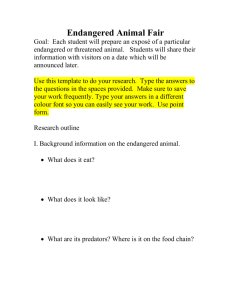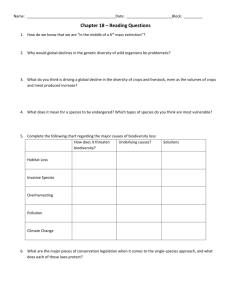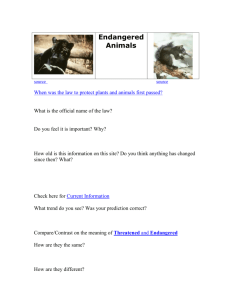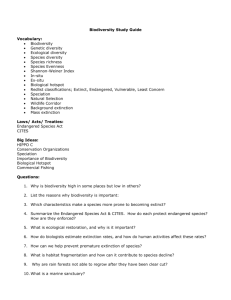Ch. 12,13 notes
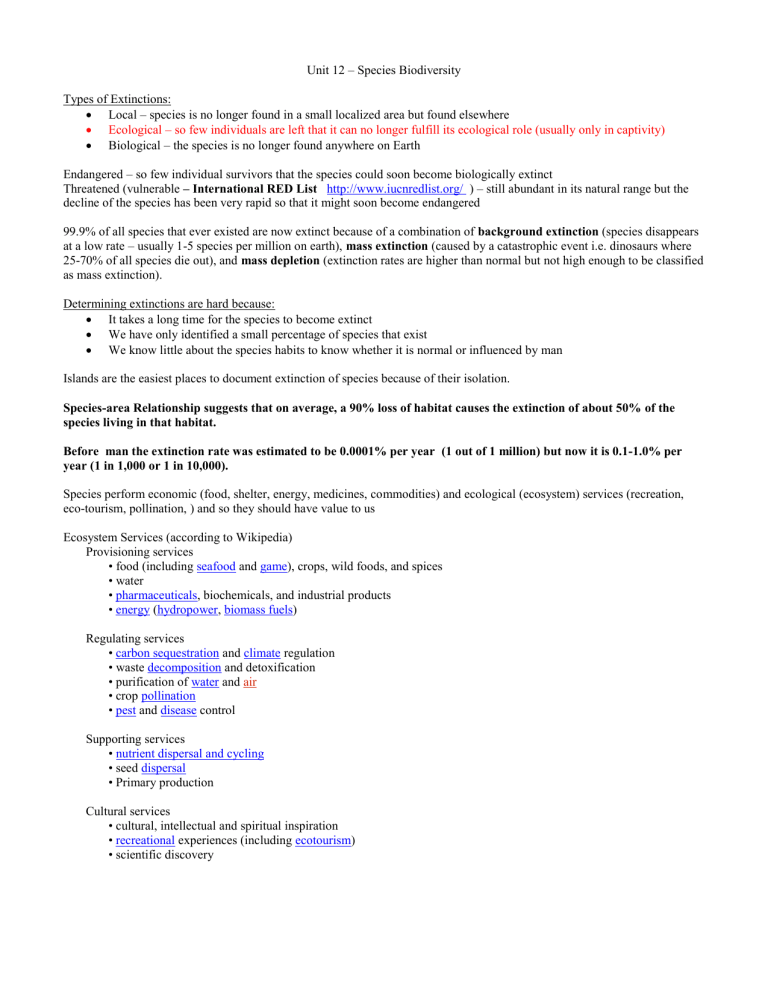
Unit 12 – Species Biodiversity
Types of Extinctions:
Local – species is no longer found in a small localized area but found elsewhere
Ecological – so few individuals are left that it can no longer fulfill its ecological role (usually only in captivity)
Biological – the species is no longer found anywhere on Earth
Endangered – so few individual survivors that the species could soon become biologically extinct
Threatened (vulnerable – International RED List http://www.iucnredlist.org/ ) – still abundant in its natural range but the decline of the species has been very rapid so that it might soon become endangered
99.9% of all species that ever existed are now extinct because of a combination of background extinction (species disappears at a low rate – usually 1-5 species per million on earth), mass extinction (caused by a catastrophic event i.e. dinosaurs where
25-70% of all species die out), and mass depletion (extinction rates are higher than normal but not high enough to be classified as mass extinction).
Determining extinctions are hard because:
It takes a long time for the species to become extinct
We have only identified a small percentage of species that exist
We know little about the species habits to know whether it is normal or influenced by man
Islands are the easiest places to document extinction of species because of their isolation.
Species-area Relationship suggests that on average, a 90% loss of habitat causes the extinction of about 50% of the species living in that habitat.
Before man the extinction rate was estimated to be 0.0001% per year (1 out of 1 million) but now it is 0.1-1.0% per year (1 in 1,000 or 1 in 10,000).
Species perform economic (food, shelter, energy, medicines, commodities) and ecological (ecosystem) services (recreation, eco-tourism, pollination, ) and so they should have value to us
Ecosystem Services (according to Wikipedia)
Provisioning services
• food (including seafood and game ), crops, wild foods, and spices
• water
• pharmaceuticals , biochemicals, and industrial products
• energy ( hydropower , biomass fuels )
Regulating services
• carbon sequestration and climate regulation
• waste decomposition and detoxification
• purification of water and air
• crop pollination
• pest and disease control
Supporting services
• nutrient dispersal and cycling
• seed dispersal
• Primary production
Cultural services
• cultural, intellectual and spiritual inspiration
• recreational experiences (including ecotourism )
• scientific discovery
Bats (keystone species): are in danger of extinction due to slow reproduction, disruption of their habitat (caves), and a parasite
70% feed on insects
Some are pollinators
Some disperse fruit seeds
Factors leading to premature extinction:
Acronym –HIPPO - habitat destruction and fragmentation, invasive species introduction, population growth of humans, pollution, and overharvesting It might help you remember it!
Birds (environmental indicator species):
Ecological Roles
Help control rodents and insects
Pollinate a variety of plants
Disperse fruit seeds through excretion
Some are scavengers helping to aid decomposition
Reason they are good environmental indicators
Live in every climate and biome
Respond quickly to environmental changes in their habitats
Easy to track and count
Invasive Species are a big problem because they have NO NATURAL PREDATORS. This allows them to outcompete the native species, causing their local extinction. Most successful invasive species have R-selected (generalist) characteristics.
Laws protecting Species:
CITES (Convention on International Trade in Endangered Species) – prohibits the trade of endangered species (live, parts, etc) between countries
CBD (Convention on Biological Diversity) – requires signing nations to inventory its biodiversity and develop a national conservation strategy to preserving that biodiversity
Lacey Act – prohibits transporting live or dead wild animals or their parts across state borders without a federal permit
Endangered Species Act (ESA) – identify and protect endangered species in the US and abroad as well as protecting their habitat. The Fish and Wildlife Service and the National Marine Fisheries Service are the groups that identify the endangered species.
The areas that I have underlined help you notice the difference between CITES and Lacey ACT – one is between countries and the other is only between states!
From 1973 -2004 the number of endangered and threatened species protected by this act grew from 92 to 1,260 species
Critical habitats for more than ½ of the listed endangered and threatened species in the US are found on private land.
Physical Taking – the government physically takes private property to create roads, etc.
Regulatory Taking – the government reduces the value of your property by limiting what you can do to it due to the endangered species
1.Habitat Conservation Plans – landowners, developers, or logger are allowed to destroy some critical habitat or kill all or part of an endangered or threatened species population on private land IN EXCHANGE for taking steps to protect that species a (setting aside some land as protected habitat, protecting critical nesting sites, maintaining travel corridors for the species involved, paying to relocate the species to another suitable habitat, removing competitors and predators, or paying money to have the government buy suitable habitat elsewhere).
2.Safe Harbor Agreement – landowners voluntarily agree to take specified steps to restore, improve, or maintain habitat for threatened or endangered species located on their land in return for technical help and also that they will not face future restrictions once the agreement is over, and after the agreement has expired it will be allowed to return to its natural condition without any penalty.
3.Voluntary Candidate Conservation Agreement – landowners agree to take specific steps to help conserve a species whose population is declining but is not yet listed as endangered or threatened in return for technical help and assurances that no additional resource-use restrictions will be imposed on the land covered by the agreement if the species is listed as endangered or threatened in the future.
Methods to Maintain or Increase Species Survival:
Increase the number and size of protected sanctuaries (reserves and parks)
Establishing gene and seed banks to preserve and record the genetic diversity
Establish botanical gardens/arboretums to protect sensitive plant species
Establish farms to raise threatened species
Chp 13 – Sustaining Aquatic Biodiversity
Coral reefs (#1), estuaries (#2), and then the deep-ocean floor (#3) contain the most marine biodiversity
Biodiversity is higher near coasts than in the open sea because of the greater variety of nutrients, producers, habitats, and nursery areas
Biodiversity is higher in the benthic region than in the pelagic region (top) because of the greater variety of habitats and food sources
Mangrove forests swamps have disappeared due to development, growing crops and shrimp farms
Bycatch – nontargeted marine animals and fish that are caught in nets with the target fish (seals, dolphins, sea turtles) They have sea turtle excluders to help the turtles escape! It’s like a trap door in a net.
` Types of commercial fishing techniques
These types of commercial fishing are really HUGE- several miles long.
Human activities that affect marine ecosystems and fishing:
Overfishing
Habitat destruction
Introduction of invasive species through ballast water of ships
Pollution of waters with organic pollutants, municipal waste, pesticides, fertilizers
Ballast is the part of the ship where they take in/discharge water to keep the ship stable while loading/unloading/transporting goods.
Fish Farming- Aquaculture
Laws Protecting Marine Species:
Convention on International Trade of Endangered Species (CITES)
Global Treaty on Migratory Species
US Marine Mammal Protection Act
US Endangered Species Act
US Whale Conservation and Protection Act
International Convention on Biological Diversity
Commercial Extinction – when it is no longer profitable to hunt and kill animals for food source (whales were the first)
United Nations Law of the Sea – all coastal nations have sovereignty up to 12 miles offshore but each country decides on their own fishing policy (many overfish)
Marine Protected Areas – a global system, mostly at the national level, of areas that protect some areas from human activities
Marine Reserves – fully protected areas or no-take MPAs where no extraction and alteration of any living or nonliving resources is allowed (again –mostly done by individual nations within their water right)
Zoning of marine areas probably will be able to protect marine ecosystems better than setting perimeter limits for nations.
Methods for Managing Fishing and Fisheries:
Set catch limits below the maximum sustainable yield
This one needs to be clarified because it is a
Charge fees for harvesting fish and shellfish from publicly owned offshore waters
Certify sustainable fisheries (fish farms currently unregulated)
quota.
Improve monitoring and enforcement of regulations
Reduce/eliminate fishing subsidies
Establish no-fishing areas
Establish more protected areas
Rely more on integrated coastal management
Label sustainably harvested fish
Publicize overfished and threatened species
Use wide-meshed net to allow escape of smaller fish
Use net escape devices for seabirds and turtles
Ban throwing edible and marketable fish back into the sea
Restrict coastal locations for fish farms
Control pollution more strictly
Depend on more herbivorous fish species
Kill organisms in ship ballast water with nitrogen to prevent invasive species
Dump ballast water far out in open ocean water and replace with deep-sea water
Lobster fishing in Maine – the fishermen have grid areas where they put their pots. These areas are ‘owned’ by families and others can’t put their pots there unless given permission. Only lobsters within a certain size are allowed to be harvested. The others (large and small) are returned to the water where they came from. Breeding females (those with eggs) are notched and then returned. The notch lets other lobstermen know that they are breeding females and cannot be harvested so that they insure a new generation of lobsters. That means year after year they are protected. Large lobsters are returned because they are considered good breeding stock.
Individual Transfer Quotas – the government gives each fishing vessel owner a specified percentage of the total allowable catch for a fishery in a given year.
Maximum Sustainable Yield (MSY) – the maximum number of a species that can be harvested annually from a stock without causing a population drop.
Salmon (keystone species) – decaying carcasses at spawning grounds provide fertilizer for adjacent trees and vegetation and food for scavengers and decomposers
Human influence affecting salmon:
Dams preventing upstream migration
Sediment from mining and logging in spawning areas
Lowered stream elevation due to water withdrawal for irrigation
Escaped ranch salmon interbreed with wild salmon and reduce the genetic diversity and their ability to survive
Overfishing of wild salmon





